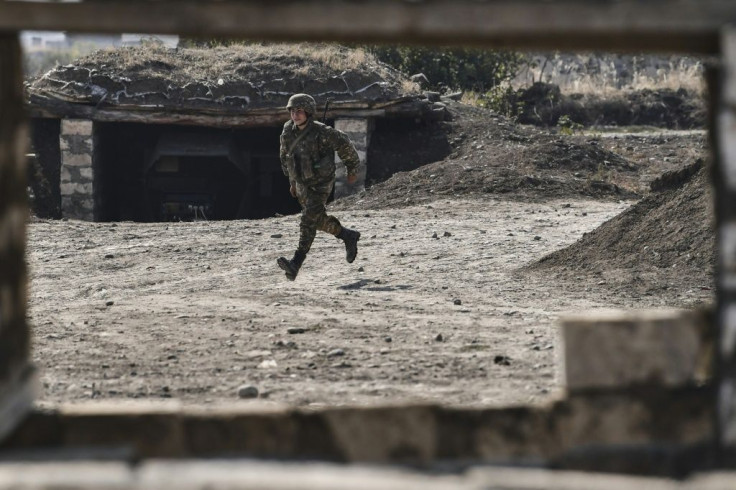Tension And Defiance In Trenches Of Karabakh
Scorched grass, some trees on the horizon and coils of barbed wire are visible from a small slit in the wall protecting a trench on the frontline of Nagorno-Karabakh.
Here Armenian soldiers seeking to keep control of the disputed region of Azerbaijan take turns to watch the activities of their foe in the Azerbaijan-held territory, located just 100 metres (328 feet) away.
The afternoon has been comparatively calm on this part of the Karabakh frontline. But in other places fighting had resumed between Armenia and Azerbaijan, each blaming the other for violating a new ceasefire hours after it came into force.

As the servicemen are standing outside in the sun, the humming of a military drone forces them to swiftly take cover.
"It finds a moving object, approaches it and explodes, hitting its target and dispersing shrapnel," said soldier Armen Asatryan, 18. Most victims in the conflict had been from drone strikes, he added.
So far the clashes that broke out late last month have claimed more than 800 lives, dozens of them among civilians. The toll could be higher as Azerbaijan does not provide the number of its military casualties.

Once the unit is given the all-clear, soldiers can resume their duties outside.
A Kalashnikov rifle in hand, one of the servicemen takes his turn on watch.

He climbs a set of steps to reach a narrow fortified observation post -- a space just big enough for one person to stand.
The soldier's eyes are fixed on the enemy's territory.
At another look-out post, AFP journalists saw Kalashnikov casings from recently-fired bullets scattered on the ground.
"The night (Saturday to Sunday) was relatively tense. But the fighting spirit and morale of our personnel is high," major Vladimir Nazlukhanyan, the commander of the unit, said.

He asked AFP not to reveal their precise location for security reasons.
This wide V-shaped trench was built just after conflict broke out between the two ex-Soviet states in the early 1990s.
For decades since the two countries have been locked in bitter conflict over this mountainous region populated by ethnic Armenians.
Karabakh's self-declared independence has not been recognised internationally, even by Armenia, and it remains a part of Azerbaijan under international law.
The walls of the three-metre-deep trench are made up of earth and mud, in some places reinforced with large stacked tires.
Concrete rails line the winding path which leads to a stone bunker where soldiers can rest in between their shifts on iron beds with mattresses and sleeping bags.
Just outside towels and T-shirts are drying on thin lines of string.
Makeshift alarm bells -- rusty tins tied onto string like beads -- are found around the area occupied by the unit.
In the wall of the bunker, a small shrine is tucked away above munition crates, displaying an Armenian cross, icons and prayers written on a small parchment scroll.
He is now retired and volunteered to come from the Armenian capital Yerevan to join the fighting.
"Nobody can beat an Armenian soldier. When an Armenian stands strongly on his feet, he will repel everybody," he said with a piercing stare.
© Copyright AFP {{Year}}. All rights reserved.





















